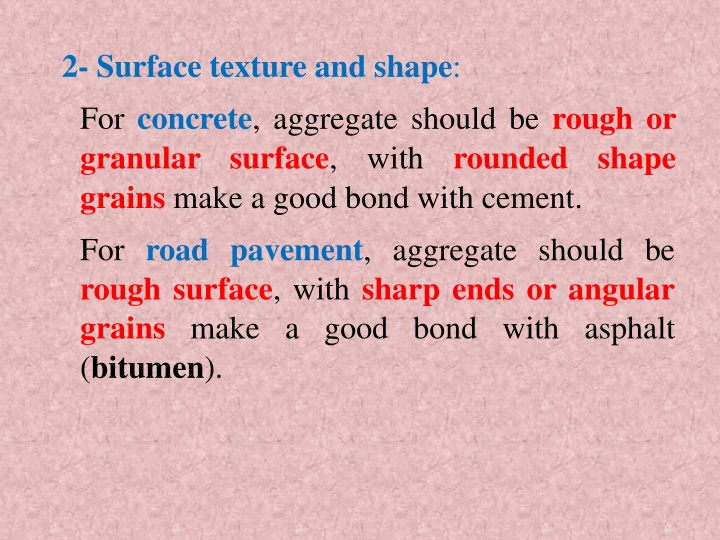
Importance of Aggregate Properties in Concrete Construction
Learn about the significance of surface texture, shape, and deleterious materials in aggregates used in concrete construction. Understand how fines, organic impurities, salts, and sulfides affect the performance of concrete. Discover the essential physical and mechanical properties of aggregates that must be tested for optimal concrete durability.
Download Presentation

Please find below an Image/Link to download the presentation.
The content on the website is provided AS IS for your information and personal use only. It may not be sold, licensed, or shared on other websites without obtaining consent from the author. If you encounter any issues during the download, it is possible that the publisher has removed the file from their server.
You are allowed to download the files provided on this website for personal or commercial use, subject to the condition that they are used lawfully. All files are the property of their respective owners.
The content on the website is provided AS IS for your information and personal use only. It may not be sold, licensed, or shared on other websites without obtaining consent from the author.
E N D
Presentation Transcript
2- Surface texture and shape: For concrete, aggregate should be rough or granular surface, with grains make a good bond with cement. For road pavement, aggregate should be rough surface, with sharp ends or angular grains make a good bond with asphalt (bitumen). rounded shape
3- Deleterious materials and its effects: Deleterious materials are alkalis, fines, flaky & elongated particles, organic materials, salts (chloride & sulphate), sulphide (pyrite). Alkali silica reaction (concrete cancer): If SiO2 minerals is present in the form of opal (finely crystalline), chalcedony (weakly crystalline) (amorphous silica) (quartz is inert because coarse grained), react with alkalis from cement (K & Na) form alkaline siliceous gel, which absorbs water from the concrete, increases in volume and causes its cracking. So use low alkali cement (alkalis < 0.6%) as ordinary Portland cement contains alkalis < 1.5%. volcanic glass or
The fines (silt & clay) may be present as coatings the aggregates which is lessening the bond between aggregate and cement past. Low quantity (free) of fines make a good bond with cement. Flaky & elongated grains of mica are harmful materials, they orient in a parallel direction and water accumulates beneath them.
The organic impurities products of decay the vegetable matter, then appears as organic loam on aggregate, which effect on hydration of cement. Salts (sulphate & chlorides) adsorb moisture from air and cause efflorescence (white deposits) on the surface of the concrete. Chlorides may also cause corrosion of reinforced iron and lessening of concrete strength. Sulphate reacts with C3A calcium aluminates phase in cement, so cause expansion and cracking. Sulphide (pyrite) oxidize to FeSO4, H2SO4, or H2S causing cracking.
4- Physical and mechanical properties of aggregate: Aggregate must be strong, low water absorption & porosity, and resist frost action. Aggregate must be tested for: 1-Aggregate impact value (AIV) 2-Aggregate abrasion value (AAV) 3-Aggregate crushing value (ACV) 4- Polished stone value (PSV) 5- Water absorption, porosity & density of aggregate 6- Soundness test of aggregate: immersion in a saturated solution of Na2SO4 or MgSO4 , the formation of salt crystals in the pores of aggregate in a similar manner of the ice.
